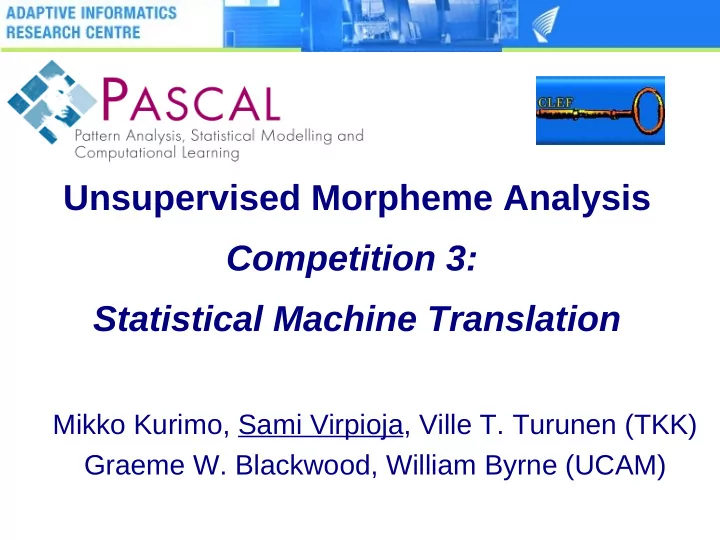

Unsupervised Morpheme Analysis Competition 3: Statistical Machine Translation Mikko Kurimo, Sami Virpioja, Ville T. Turunen (TKK) Graeme W. Blackwood, William Byrne (UCAM)
Morphology and SMT • Statistical machine translation systems find translation probabilities between words or sequences of words (“phrases”). • Languages of rich morphology tend to be hard to translate both from and to – e.g. Finnish is one of the hardest among the EU languages. • Still unsolved problem
Morph-based translation • Can unsupervised morphology learning directly improve SMT? – Reduces out-of-vocabulary rates (S. Virpioja, J. Väyrynen, M. Creutz & M. Sadeniemi, Morphology- aware statistical machine translation based on morphs induced in an unsupervised manner, MT Summit XI, 2007) – Improves translation results (A. de Gispert, S. Virpioja, W. Byrne, M. Kurimo, Minimum bayes risk combination of translation hypotheses from alternative morphological decompositions, HLT-NAACL, 2009)
Tasks and data • Europarl parallel corpus – Proceedings of the EU parliament meetings in 11 European languages • { Finnish, German } → English – Reducing OOV problems at the source side – Finnish: 479 780 word types – German: 270 038 word types • ~1 million sentences for training, <3000 for tuning, 3000 for testing
System overview • Evaluation based on combination of word-based and morph-based SMT systems (de Gispert et al., 2009)
Phrase-based SMT • One of the major advances in SMT methodology in this decade • Open source software: Moses (P. Koehn et al., 2007) • Main steps in building a system with Moses: – Word alignment (Giza++) – Phrase extraction and scoring – Building additional models (language model, reordering model, etc.) – Parameter tuning for decoder
MBR and system combination • Minimum Bayes Risk (MBR) decoding: – Select translation hypothesis which maximises the conditional expected gain: E ∈ e ∑ G E , E = argmax E P E ∣ F E ∈ e • System combination: generate N-best lists from different systems and find the best hypothesis with the MBR criterion
MT evaluation • There are several metrics for automatic evaluation of MT systems. • BLEU score is based on co-occurrence of n-grams (n=1...4) in the proposed translation and the reference translation(s). • Usually consistent with human evaluations if the evaluated systems are similar
Submissions to Competition 3 • Bernhard – MorphoNet (MN) • Monson et al. - ParaMor Mimic (PM) • Monson et al. - ParaMor Morfessor Mimic (PMM) • Monson et al. - ParaMor Morfessor Union (PMU) • Virpioja & Kohonen – Allomorfessor (A) • Tchoukalov et al. - MetaMorph (MM) • Reference methods: Morfessor Baseline (MB), Morfessor CatMAP (MC), Grammatical (G)
Example translations (1) Words Grammatical gold standard
Example translations (2) Bernhard - MorphoNet Monson et al. - ParaMor-Morfessor Union
Example translations (3) Virpioja & Kohonen - Allomorfessor Tchoukalov et al. - MetaMorph
Results: Finnish
Results: German
Discussion • Too long (>100 tokens) sentences cannot be handled by Giza++. – Segmentation decreases the amount of training data. – Direct effect on performance • However, the number of average morphs per word does not explain the number of pruned sentences.
Conclusions • 6 submitted and 3 reference methods were tested on two machine translation tasks. • The 3-5 best methods improved the translation results over the baseline word-based system. • Some improvements are needed to make the comparison more fair. • Full report and papers in the CLEF proceedings • Details, presentations, links, info at: http://www.cis.hut.fi/morphochallenge2009/
MBR: A toy example F = “Kahvi oli vahvaa.” E1 = “The coffee was powerful.” P(E1 | F) = 0.4 E2 = “The coffee tasted strong.” P(E2 | F) = 0.4 E3 = “The coffee was strong.” P(E3 | F) = 0.2 G(x,y) = the number of common words E1: 4 * 0.4 + 2 * 0.4 + 3 * 0.2 = 3.0 E2: 2 * 0.4 + 4 * 0.4 + 3 * 0.2 = 3.0 E3: 3 * 0.4 + 3 * 0.4 + 4 * 0.2 = 3.2
Recommend
More recommend